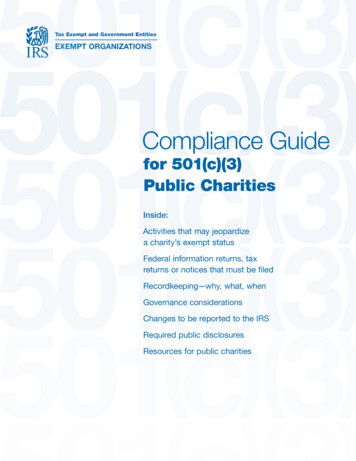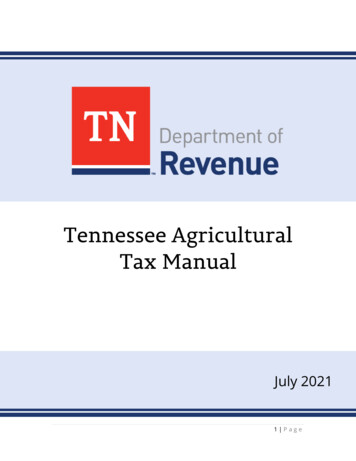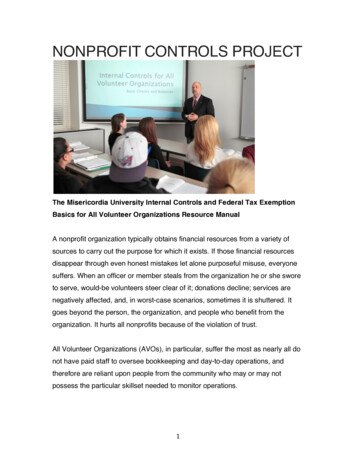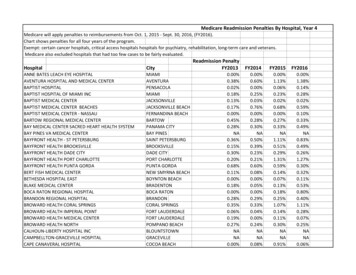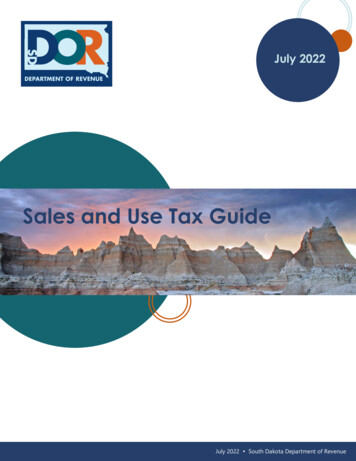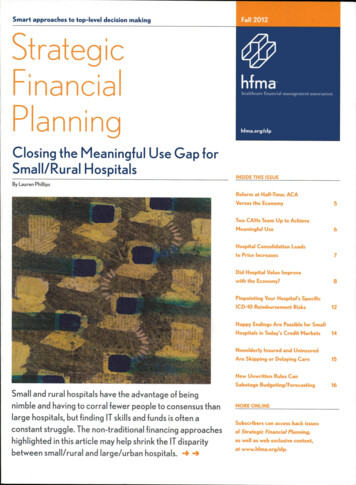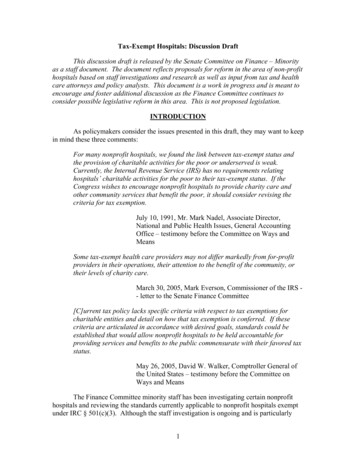
Transcription
Tax-Exempt Hospitals: Discussion DraftThis discussion draft is released by the Senate Committee on Finance – Minorityas a staff document. The document reflects proposals for reform in the area of non-profithospitals based on staff investigations and research as well as input from tax and healthcare attorneys and policy analysts. This document is a work in progress and is meant toencourage and foster additional discussion as the Finance Committee continues toconsider possible legislative reform in this area. This is not proposed legislation.INTRODUCTIONAs policymakers consider the issues presented in this draft, they may want to keepin mind these three comments:For many nonprofit hospitals, we found the link between tax-exempt status andthe provision of charitable activities for the poor or underserved is weak.Currently, the Internal Revenue Service (IRS) has no requirements relatinghospitals’ charitable activities for the poor to their tax-exempt status. If theCongress wishes to encourage nonprofit hospitals to provide charity care andother community services that benefit the poor, it should consider revising thecriteria for tax exemption.July 10, 1991, Mr. Mark Nadel, Associate Director,National and Public Health Issues, General AccountingOffice – testimony before the Committee on Ways andMeansSome tax-exempt health care providers may not differ markedly from for-profitproviders in their operations, their attention to the benefit of the community, ortheir levels of charity care.March 30, 2005, Mark Everson, Commissioner of the IRS - letter to the Senate Finance Committee[C]urrent tax policy lacks specific criteria with respect to tax exemptions forcharitable entities and detail on how that tax exemption is conferred. If thesecriteria are articulated in accordance with desired goals, standards could beestablished that would allow nonprofit hospitals to be held accountable forproviding services and benefits to the public commensurate with their favored taxstatus.May 26, 2005, David W. Walker, Comptroller General ofthe United States – testimony before the Committee onWays and MeansThe Finance Committee minority staff has been investigating certain nonprofithospitals and reviewing the standards currently applicable to nonprofit hospitals exemptunder IRC § 501(c)(3). Although the staff investigation is ongoing and is particularly1
interested in the results of the forthcoming IRS study and survey of tax-exempt hospitals,the staff has identified several areas of concern as it pertains to the tax-exempt status ofnonprofit hospitals.1 The staff is concerned that many nonprofit hospitals receivesubstantial federal income tax benefits and subsidies without providing commensuratebenefits to society.2 It is estimated that nonprofit hospitals receive between 12.6 billionand 20 billion a year in benefits from tax-exemption at the federal, state and local level.3A recent Congressional Budget Office (CBO) report found that nonprofit hospitalsprovided only slightly more uncompensated care than for-profit hospitals, based on a fivestate survey.4In addition, it is important to note that CBO and other researchers havedetermined that there are significant differences between individual nonprofit hospitals interms of the amount of uncompensated care or charity care each hospital provided. Ingeneral, according to CBO, nonprofit hospitals provide a mean of 4.7 percentuncompensated-care as a share of total hospital operating expenses. However, as a meansuggests, CBO reports there are quite a few nonprofit hospitals that provide significantlymore than 4.7 percent in uncompensated-care and, unfortunately, many nonprofithospitals providing less than 3 percent in uncompensated-care. Other researchers havefound that a number of nonprofit hospitals do very little in providing charity care. Inbrief, some nonprofit hospitals are helping pull the wagon when it comes to charity carebut far too many nonprofit hospitals are sitting in the wagon – receiving significant taxbreaks but providing little to nothing in the way of charity care for those in need in oursociety.51For the purposes of this discussion draft, the term “nonprofit hospitals” refers to hospitals that are exemptfrom Federal income tax under §501(c)(3).2See testimony of Nancy Kane before the Senate Finance Committee, September 13, 2006 (Several studieshave shown that the majority of tax-exempt hospitals do not provide charity care commensurate with thevalue of their tax exemptions).3According to the Joint Committee on Taxation, in the year 2002 (the most recent year for which statisticsare available), the value to nonprofit hospitals of the major tax exemptions they receive from federal, stateand local governments was estimated to be 12.6 billion. See CBO Report, “Nonprofit Hospitals and theProvision of Community” Dec. 2006, p. 3. See also Kane, supra 2 (If the value of tax-exemption is roughly5% of hospital expenditures [using the guideline used in Texas’ community benefit law], then the value oftax exemption from all sources [federal, state and local] approaches 20 billion/year for private nonprofithospitals).4Congressional Budget Office Report, Nonprofit Hospitals and the Provision of Community Benefits, Dec.2006. The issues raised in this paper are not new. For a historical perspective on this and many otherissues discussed in this paper, policymakers should review “Nonprofit Hospitals: Better Standards Neededfor Tax Exemption,” General Accounting Office GAO? HRD-90-84 (May 1990); “Hospital Charity Careand Tax Exempt Status: Restoring the Commitment and Fairness” Hearing before the Select Committee onAging, House of Representatives, 101st Congress, 2nd Session, June 28, 1990; and, “Free Ride: The Taxexempt Economy” Chapter 3 “Charitable hospitals: Where’s the charity?” by Gilbert Gaul and NeillBorowski, Andrews and McMeel (1993).5See statement of David Walker, Comptroller General of the United States, “Nonprofit, For-Profit, andGovernment Hospitals: Uncompensated Care and Other Community Benefits,” before the Committee onWays and Means, May 26, 2005 (Further, within each group [of for-profit and nonprofit hospitals], theburden of uncompensated care costs was not evenly distributed among hospitals but instead wasconcentrated in a small number of hospitals. This meant that a small number of nonprofit hospitalsaccounted for substantially more of the uncompensated care burden than did others receiving the same tax2
Specifically, the staff is concerned about: establishment of charity care policiesand wide publication of those policies at nonprofit hospitals; amount of charity care andother community benefits provided by nonprofit hospitals; conversion of nonprofithospital assets for use by for-profit entities; ensuring that an exempt purpose is furtheredin joint ventures between a nonprofit hospital and a for-profit entity; transparency andaccountability of nonprofit hospital governance and activities; and use of unfair billingand aggressive collection practices by nonprofit hospitals particularly with respect tolow-income families. Finally, the staff believes that the present community benefitstandard is extraordinarily vague and does not correlate with the federal tax benefitsreceived by the hospital.In this draft, the staff suggests various alternatives to be considered in draftinglegislation to reform nonprofit hospital federal tax-exemption. The staff recommends theimplementation of an exempt hospital structure which provides different requirementsdepending on whether the organization seeks to be classified as an IRC § 501(c)(3) or §501(c)(4) exempt organization. While both §501(c)(3) and (c)(4) organizations areexempt from Federal income tax, § 501(c)(3) organizations receive the additional benefitsof being able to issue tax-exempt bonds and receive contributions that are deductibleunder section 170. The requirements for § 501(c)(3) status should be more stringent thanthe requirements for § 501(c)(4) status to be commensurate with these additional taxbenefits. Staff are unaware of any hospitals that are currently a 501(c)(4). The commonpractice is that a nonprofit hospital is classified as a 501(c)(3).The staff proposal recommends setting specific standards for hospitals that seekexemption under § 501(c)(3), including: (i) establishing a charity care policy and widepublication of that policy; (ii) quantitative standards for charity care; (iii) requirementsfor joint ventures between nonprofit hospitals and for-profit entities; (iv) boardcomposition and other governance requirements and executive compensation; (v) limitingcharges billed to the uninsured; (vi) placing restrictions on conversions; (vii) curtailingunfair billing and collection practices; (viii) transparency and accountabilityrequirements; and, (ix) sanctions for failure to comply with applicable requirements for a501(c)(3) or 501(c)(4) hospital.The staff proposal recommends setting standards for hospitals that seekexemption under 501(c)(4) including: (i) a quantitative amount of community benefitsannually; (ii) limiting charges billed to the uninsured; (iii) governance reforms; (iv)restrictions on conversions; (v) curtailing unfair billing and collection practices; (vi)heightened transparency; and, (vii) sanctions for failure to comply with applicablerequirements.The proposals would apply in addition to existing legal requirements generallyapplicable to § 501(c)(3) and (c)(4) organizations, such as the private inurementprohibition, but would replace Rev. Rul. 69-545 and 83-157.preference). See also “It’s All in the Numbers: A Beginner’s Guide to Charity Care Analysis” by LeslieBennett, Consumers Union (2005)(average percentage of charity care compared to total operating expensesfor all hospitals from 1995 – 1999: 132 hospitals had zero charity care; 307 had 0.01% to 1.00%; 52 had1.01% - 2.00%; 37 had 2.01% - 5.0%; and, 20 had 5.01% and above).3
It is important that policymakers be cautious in relying on reforms in this areathrough voluntary efforts by nonprofit hospitals instead of through regulatory or statutorychanges. While some nonprofit hospitals do a good job of providing charity care to thosein need, there are far too many nonprofit hospitals that say the right words but too oftenfail to do the right thing when it comes to providing for low-income families.6The staff believes that implementation of these proposed changes will bring realand meaningful health benefits to low-income families. Policymakers concerned aboutaddressing the many health issues facing the nation should bear in mind that taxpayerscurrently provide billions of dollars in subsidies to nonprofit hospitals while at the sametime many vulnerable and low-income families do not receive necessary free ordiscounted care. While certainly not a cure-all, policymakers have an opportunity toimprove the health care for many low income families by ensuring that the tax benefitsprovided to nonprofit hospitals translate into health care for those in need and thecommunity at large.Congress should meet its responsibilities of being good stewards of the taxpayers’monies and ensure that in exchange for the billions of dollars given in tax breaks,nonprofit hospitals do in fact provide concrete benefits to the community, especially tothe most vulnerable in our nation.LAW CURRENTLY APPLICABLE TO NONPROFIT HOSPITALSHospitals that qualify as a tax-exempt organization under § 501(c)(3) areautomatically classified as public charities, and not private foundations.7 Prior to 1969,hospitals were eligible for § 501(c)(3) status by demonstrating charity care. Specifically,hospitals were required to be operated to the extent of their financial ability for thoseunable to pay for the services rendered. Under Rev. Rul. 56-185, tax-exempt hospitals:(i) were not allowed to refuse to accept or deny medical care or treatment to indigentpatients in need of hospital care; (ii) could furnish services at reduced rates that are belowcost; (iii) could set aside earnings for improvements and additions to hospital facilities;and (iv) could not restrict the use of its facilities to a particular group of physicians andsurgeons or otherwise have net earnings inure (directly or indirectly) for the benefit ofany private shareholder or individual.86See “Voluntary Commitments: Have Hospitals That Signed a Confirmation of Commitment to theAmerican Hospital Association’s Billing and Collections Guidelines Really Changed Their Ways?” by BillLottero and Carol Pryor, The Access Project, May 2005 and Raymont Hartz, Executive Director Legal AidSociety of Eastern Virginia, Inc., Testimony before the Senate Finance Committee, September 13, 2006(Every private hospital in Hampton Roads is non-profit. Each has a charity program, either for free-ofcharge care and/or for discounted care for the un or under-insured patient. Unfortunately, the reality is thatvery few low income, uninsured patients are ever informed of the existence of these program. . . . Thisweek I have spoken with Legal Aid programs around the country, and the problems I have described arenot unique to Virginia. In almost all the states I spoke with, the same problems are present – charity careprograms exist at the hospitals, but many eligible patients never learn of their existence).7I.R.C. § 509(a) (referring to § 170(b)(1)(A)(iii)).8Rev. Rul. 56-185.4
In concert with passage of legislation creating Medicare and Medicaid,representatives of nonprofit hospitals began advocating for the Treasury to make changesto Rev. Rul. 56-185. One of the major claims made by nonprofit hospitals was thatpassage of Medicare and Medicaid legislation would eliminate or greatly reduce thedemand for charity care – and therefore there needed to be flexibility in the requirementsfor nonprofit hospitals.In response to the lobbying of nonprofit hospitals, IRS issued new guidancerequiring that hospitals must meet a “community benefit” standard in order to be eligiblefor tax exemption under 501(c)(3). The community benefits standard is a facts andcircumstances test without any clear lines. In Rev. Rul. 69-545, the IRS set forth certainfactors that demonstrate a community benefit: (i) an emergency room open to all,including indigent patients; (ii) a board of directors drawn from the community; (iii) anopen medical staff policy; (iv) treatment of patients who pay their bills through publicprograms, such as Medicaid and Medicare; (v) use of surplus funds to improve facilities,equipment, and patient care; and (vi) medical training, education, and research. In Rev.Rul. 83-157 the IRS stated that, although operation of an emergency room open to allregardless of ability to pay is a strong factor in demonstrating community benefit, thepresence of other similar significant factors would warrant exempt status in the absenceof such an emergency room due to a determination by a state/local health planningagency that emergency room service was unnecessary and duplicative.9Current IRS guidance does not presently set forth quantitative standards for theamount of charity care or community benefits that must be provided, nor does it requirethe level of community benefits to be commensurate with the tax benefits received.Further, the present guidance by IRS establishing a community benefit standard does noteven require that a hospital provide any charity care in order to be exempt as a publiccharity. The community benefit standard has been widely viewed as a failureadministratively and, more importantly, in providing measurable benefits to low-incomefamilies.It is important for policymakers (including those in the executive branch) torecognize that Rev. Rul. 69-545 was not put forward by the IRS in response to anychanges in the tax laws. The new guidance in Rev. Rul. 69-545 was based on whatturned out to be an inaccurate expectation of other legislation (namely that Medicaid andMedicare would eliminate or greatly reduce the need for charity care). Nothing preventsthe executive branch from issuing new guidance that establishes (or reestablishes) charitycare requirements for nonprofit hospitals.9The staff believes the enactment of the Emergency Medical Treatment and Active Labor Act(“EMTALA”), which requires all Medicare provider hospitals to screen for and stabilize any emergencymedical condition in all emergency room patients, diminishes the relevance of an open emergency room asa major factor in determining exempt status since the law is applicable to both for-profit and nonprofithospitals. See 42 U.S.C. § 1395dd. Notably, EMTALA does not prohibit a hospital from seeking paymentfor the care provided in the emergency room after treatment has been provided.5
STAFF PROPOSALThis staff proposal is divided into four sets of recommendations:(1) recommendations for special rules for hospitals exempt under § 501(c)(3);(2) recommendations for special rules for hospitals exempt under 501(c)(4);(3) recommendations applicable to hospitals exempt under 501(c)(3) and (c)(4); and;(4) recommendations applicable to all hospitals (nonprofit, for-profit, and governmenthospitals).I. Special Rules for Hospitals Exempt Under § 501(c)(3) and § 501(c)(4)The staff suggests that Congress legislate special rules for hospitals seekingexemption under § 501(c)(3) and § 501(c)(4). Because the tax benefits for § 501(c)(3)organizations are greater than those for § 501(c)(4) organizations (i.e., tax-exemptfinancing and § 170 deductible contributions), the requirements for exemption under §501(c)(3) are more stringent than those for § 501(c)(4).A. Standards Applicable to (c)(3) Hospitals:No hospital will qualify for §501(c)(3) status unless they meet the following additionalrequirements:1. A §501(c)(3) Hospital Must Develop a Charity Care Policy and Publicize It.Minimum Requirements for Charity CareConsumer advocacy groups have found that many hospitals either do not offer charitycare policies, or if they do, it is difficult for a patient to find out more about theprocedures for obtaining such care. To remedy this problem, the staff recommends thateach § 501(c)(3) hospital be required to develop a written charity care policy that setsforth eligibility requirements, procedures for obtaining free or discounted care, and wherea patient can obtain more information.10 Such policies must be made available: (1) onhospital websites, in emergency rooms, and in admissions offices, at all times; and (2) tomembers of the public, the IRS, and the Department of Health and Human Services(HHS) upon request. In addition, notice of the availability of charity care and whereadditional information may be obtained should be widely posted in areas that will ensurenotice by patients. Charity care policies should be written in plain language and in amanner that is easily understandable by the general public. These policies should also bemade available in multiple languages if the needs of the community require it.10In the explanation of reforms of charitable credit counseling organizations included in the PensionProtection Act of 2006, the Joint Committee on Taxation noted that the provision of services and waiver offees without regard to ability to pay and the establishment of a reasonable fee policy and independent boardmembers are core issues to the matter of tax exemption . See General Explanation of Tax LegislationEnacted in the 109th Congress, Joint Committee on Taxation (January 17, 2007) p. 612 fn 858.6
The staff recommends that the minimum eligibility threshold for all charity carepolicies shall be no less than 100% of the federal poverty level (FPL) and policymakersmay want to consider a policy above 100%. That is, nonprofit hospitals should providefree of charge medically necessary in/out patient hospital services (not otherwise coveredby Medicaid, etc.) to all individuals at or below the federal poverty level.112. A §501(c)(3) Hospital Must Provide Quantitative Amounts of Charity CareAnnuallyThe staff believes that merely offering a charity care policy is not enough tojustify exemption under Section 501(c)(3) – charity care must actually be provided. Thestaff considered various alternatives, including requiring a hospital to provide charity careto every person who satisfies the charity care policy, an annual minimum aggregatecharity care amount, and a rolling average charity care amount over several years. Thestaff recommends that no hospital can maintain § 501(c)(3) status without dedicating aminimum of 5% of its annual patient operating expenses or revenues to charity care,whichever is greater, in accordance with its charity care policy.12 The 5% test is based onstaff review (discussed further below) and reflects the common practice of the IRS inauditing nonprofit hospitals prior to the 1969 regulatory changes.13 Note: the 5% testmust be met using the same measure/criterion for the numerator and the denominator –i.e., if the hospital uses operating expenses for the 5% test, the hospital must measure thatagainst operating expenses overall. Staff believes a transition period to meeting the 5%test is warranted. Critical access hospitals would be exempt from this provision.14For this purpose, charity care is defined as:(a)medically necessary in/out patient hospital services provided withoutexpectation of payment from or on behalf of the individual receivingthe hospital services (example, those at FPL 100% or below whoreceive free care as discussed in Section A.1. above);1511The policy of charity care for those at 100% FPL is a common standard for nonprofit hospitals, withmany nonprofit hospitals providing a higher standard. For example, the Iowa Health System has a policyof providing charity care for those up to 200% FPL.12Policymakers may also wish to consider “net income” as the basis for measuring the amount of charitycare required. For example, the Daughters of Charity had a policy that required hospitals to devote 25% ofnet income to care of the poor. However, staff has concerns about manipulation of this measurement.13See Statement of John Colombo to the House Ways and Means Committee, Footnote 3(IRS auditingagents often denied or revoked exempt status if a hospital’s charity care was less than 5% of grossrevenues) May 27, 2005.14Under federal law, a critical access hospital is located in a rural area and meets one of the followingcriteria: (i) be located over 35 miles away from another hospital; (ii) be located 15 miles from anotherhospital in mountainous terrain or areas with only secondary roads; or (iii) be state-certified as a necessaryprovider of health care services to residents in the area.15See generally the definition of free care and charity care for the States of Maine and Rhode Island, SeeCode Me. R. 150:10-144-1.01(c) , Me. R. 150.10-144-10(c) and CRIR 14-090-007. For a discussion ofstate charity care laws see Rachael Kagan and Erinmauriah Conway, “State of the States’ Charity Care7
(b)the amount of revenue, less any payments received for patient care,which is expected to be written off as a result of a designation (prior tobilling) that the patient is unable to pay for the medically necessaryhospital services. This would include discounts to low-incomeuninsured individuals (FPL 100% to 300%) as well as free ordiscounted care to the underinsured or medically indigent (FPL 100%to 300%). Discounts (and foregone revenue) would be valued based onthe reduction of price from the value of care stated below; and,(c)providing medical care through free clinics and community medicalclinics as well as other means of providing free medical care tovulnerable populations such as school-based programs.16 Alsoincluded would be grants to other charities that provide free medicalcare to vulnerable populations through free clinics, community medicalclinics, etc.The value of care provided will be based on a rate that equals the lower of: (i) thelowest rate that would be paid by Medicare/Medicaid or (ii) the actual unreimbursed costto the hospital for such service. Charity care would not include bad debt. Staff views itas inappropriate for a hospital to seek payment from a patient by sending a bill, and whenpayment is not received, to seek to recharacterize that debt as charity care. In addition,staff has found that the decision by some hospitals to include bad debt (which oftenconsists of very high charges from the “chargemaster list” – see discussion below)provides a misleading and inflated accounting of a hospitals’ charity care to policymakersand the public. The same issue of inflated and misleading accounting also applies when ahospital uses the “chargemaster” list to quantify charity care.Staff recognizes that hospitals can face a significant burden or barrier with somepatients in establishing whether the patient is eligible for charity care. However,hospitals that emphasize and make a priority of establishing patient eligibility for charitycare have had good success in minimizing this problem. Staff believes that flexibilityshould be provided to hospitals to determine eligibility for charity care after medicalservices have been provided but before the patient is billed. Finally, staff believes thathospitals should be allowed some flexibility in deciding on the data necessary todetermine eligibility for charity care -- as suggested by the Healthcare FinancialManagement Association (HFMA).17Laws,” Nicholas C. Petris Center on Health Care Markets and Consumer Welfare University of California,Berkeley, School of Public Health (September 2001).16This expanded view of charity care and benefits a nonprofit hospital can/should provide is informed bythe concept of “enhancing access” discussed in “Symposium: Health Care and Tax Exemption: The Pushand Pull of Tax Exemption on the Organization and Delivery of Health Care Services: The Failure ofCommunity Benefit,” by John Colombo, 15 Health Matrix 29, 62 (Winter, 2005).17See HFMA Principles and Practices Board Statement No. 15, “Valuation and Financial StatementPresentation of Charity Service and Bad Debts by Institutional Healthcare Providers,” paragraphs 3.7 and3.8, (December 5, 2006). In addition policymakers would benefit from a review of the entire StatementNo. 15. The staff recommendations in this section are similar in many aspects to Statement No. 15 butdiffer in some parts, particularly in regards to determining for how long bad debt can still be converted to8
The term “medically indigent” includes “patients whose health insurancecoverage, if any, does not provide full coverage for all of their medical expenses and thattheir medical expense, in relationship to their income, would make them indigent if theywere forced to pay full charges for their medical expenses.”18 The staff recommendsdefining the term “underinsured” as a patient who “has insurance all year but hasinadequate financial protection, as indicated by one of three conditions: 1) annual out-ofpocket medical expenses amount to 10% or more of income; 2) among low-income adults(incomes under 200 % FPL), out-of-pocket medical expenses amount to 5% or more ofincome; or 3) health plan deductibles equal or exceed 5% of income.”19The staff reviewed a 2005 GAO report regarding billing practices, which studiedthe average percent of patient operating expenses devoted to uncompensated care in thehospital systems in five states: (1) California – 3.2%; (2) Florida – 5.5%; Georgia – 6.9%;Indiana – 4.3; and Texas – 6.7%.20 The average from these figures is 5.32% -- butpolicymakers should keep in mind that these figures include bad debt. Based on theresults of this study and similar reviews, the CBO study discussed earlier, pre-1969 IRSpractice and a review of different state and federal charity care requirements summarizedbelow, the staff believes that a charity care requirement equivalent to at least 5% ofpatient operating expenses or revenues (whichever is greater) would be reasonable. Thefollowing are some of the charity care requirements (or proposed) under federal or statelaw studied by staff, which policymakers may want to review for comparison purposes: Hill-Burton Act: The provisions of this Act passed into law in 194621 mandate that,in order to receive funding for certain facility construction and modernization,hospitals must provide “uncompensated services” in an amount equal to the lesser of:3% of the hospital’s operating costs, or 10% of all Federal assistance provided to oron behalf of the hospital with certain adjustments. Illinois: During the 2006 legislative session, the Illinois Attorney General proposed abill that would mandate hospitals to devote 8% of their annual operating costs tocharity care.22 Critical access hospitals were excluded from the provisions of the bill.charity care. Statement No. 15 views that it is desirable to determine eligibility for charity care at the timeservice is rendered but would continue to allow for bad debt to be considered charity care even after thepatient has been billed (assuming that it was determined the patient was eligible and that the hospital had inplace a good-faith effort and policy to determine eligibility at time of service and prior to billing).18Term as defined by the Centers for Medicare and Medicaid Services (CMS), ads/FAQ Uninsured.pdf19Insured But Not Protected: How Many Adults Are Underinsured?, Cathy Schoen, M.S., Michelle M.Doty, Ph.D., Sara R. Collins, Ph.D., and Alyssa L. Holmgren, Health Affairs Web Exclusive, June 14, 2005W5-289–W5-302 (synopsis available athttp://www.cmwf.org/publications/publications show.htm?doc id 280812)20See “Nonprofit, For-profit, and Government Hospitals,” Statement of David M. Walker, ComptrollerGeneral of the United States, GAO-05-743T, p. 11, Fig. 2.21See 42 CFR § 124.503 for applicable provision.22The Illinois bill did not include bad debt in the calculation, but Medicaid shortfalls would count towardthe requirement. The bill exempted governmen
value of their tax exemptions). 3 According to the Joint Committee on Taxation, in the year 2002 (the most recent year for which statistics are available), the value to nonprofit hospitals of the major tax exemptions they receive from federal, state and local governments was estimated to be 12.6 billion. See CBO Report, "Nonprofit Hospitals .
